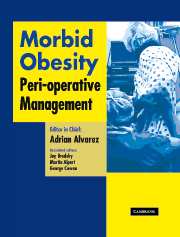Book contents
- Frontmatter
- Contents
- Contributors
- Foreword
- Preface
- Acknowledgments
- Dedication
- Section 1 General aspects
- Section 2 Pathophysiology
- Section 3 Pre-operative management
- Section 4 Peri-operative management of co-morbidities
- Section 5 Pharmacology
- Section 6 Monitoring
- Section 7 Intra-operative management
- Section 8 Post-operative care
- 25 Post-anesthetic care unit management
- 26 Respiratory management
- 27 Management of the obese critically ill patient in intensive care unit
- 28 Nursing management
- 29 Post-operative analgesia
- Section 9 Conclusions
- Afterword
- Index
28 - Nursing management
from Section 8 - Post-operative care
Published online by Cambridge University Press: 17 August 2009
- Frontmatter
- Contents
- Contributors
- Foreword
- Preface
- Acknowledgments
- Dedication
- Section 1 General aspects
- Section 2 Pathophysiology
- Section 3 Pre-operative management
- Section 4 Peri-operative management of co-morbidities
- Section 5 Pharmacology
- Section 6 Monitoring
- Section 7 Intra-operative management
- Section 8 Post-operative care
- 25 Post-anesthetic care unit management
- 26 Respiratory management
- 27 Management of the obese critically ill patient in intensive care unit
- 28 Nursing management
- 29 Post-operative analgesia
- Section 9 Conclusions
- Afterword
- Index
Summary
Introduction
Caring for the morbidly obese patient is a challenge for healthcare providers regardless of the setting. For bariatric patients who require an intensive care unit (ICU) stay, the care provided by the multidisciplinary team, especially nursing, can be quite difficult. At each stage of the patient's recovery, different aspects of care provision require adaptation and creativity since the unique requirements of the morbidly obese patient are not easily delineated by any one-care guideline. Indeed, despite the prevalence of obesity in our critically ill patients, a dearth of information exists on how to best care for them. Regardless, a systematic approach to assuring that care is optimal may achieve good outcomes in this very vulnerable patient population and is the focus of this chapter. The chapter describes some of the most common and trying aspects of nursing care such as skin and wound care, positioning and mobilization, selected aspects of ventilator management, arterial and venous access, nutrition, prevention of complications and psychological issues. It is the authors' hope that the information provided will be useful to the readers of this book on peri-operative management in the morbidly obese individual.
Skin and wound care
Maintaining the skin integrity of the morbidly obese patient requires the implementation of a proactive approach to avoid skin breakdown. Such an approach may prevent complications and the resultant prolonged duration of hospitalization associated with the complications of obesity.
- Type
- Chapter
- Information
- Morbid ObesityPeri-Operative Management, pp. 371 - 380Publisher: Cambridge University PressPrint publication year: 2004

